Abstract
The Shahejie Formation in Nanpu Sag is a crucial region for deep-layer hydrocarbon exploration in the Bohai Bay Basin. To address the impact of faults on sublacustrine fan formation and spatial distribution within the study area, this study integrated well logging, laboratory analysis, and 3D seismic data to systematically analyze sedimentary characteristics of sandbodies from the first member of the Shahejie Formation (Es1) sublacustrine fans, clarifying their planar and cross-sectional distributions. Further research indicates that Gaoliu Fault activity during Es1 deposition played a significant role in fan development through two mechanisms: (1) vertical displacement between hanging wall and footwall reshaped local paleogeomorphology; (2) tectonic stresses generated by fault movement affected slope stability, triggering gravitational mass transport processes that remobilized fan delta sediments into the central depression zone as sublacustrine fans through slumping and collapse mechanisms. Core observations reveal soft-sediment deformation features, including slump structures, flame structures, and shale rip-up clasts. Seismic profiles show lens-shaped geometries with thick centers thinning laterally, exhibiting lateral pinch-out terminations. Inverse fault-step architectures formed by underlying faults control sandbody distribution patterns, restricting primary deposition locations for sublacustrine fan development. The study demonstrates that sublacustrine fans in the study area are formed by gravity flow processes. A new model was established, illustrating the combined control of the Gaoliu Fault and reverse stepover faults on fan development. These findings provide valuable insights for gravity flow exploration and reservoir prediction in the Nanpu Sag, offering important implications for hydrocarbon exploration in similar lacustrine rift basins.
1. Introduction
With the advancement of oil and gas exploration in recent years, deep-water gravity flow sand body reservoirs have increasingly garnered attention from petroleum professionals as important venues for oil and gas accumulation. This subject is at the forefront of sedimentology and reservoir geology research, both domestically and internationally, making it a hot topic in oil and gas exploration and development [1,2,3]. There are currently numerous innovative approaches useful for reservoir exploration and development, such as micro-computed tomography (Micro-CT), digital core analysis (DCA), petrophysics-driven seismic modeling, and high-resolution synthetic seismic forward modeling, with an emphasis on reducing carbon emissions. This demonstrates the oil and gas industry’s developmental trend of maintaining traditional exploration advantages while transitioning toward high-precision, digital, and environmentally friendly technologies [4,5]. The aforementioned technical techniques enable a more precise delineation of sedimentary microfacies, identification of depositional environments, investigation into diagenetic influences, and other related geological analyses.
In the early 20th century, Johnson (1938) first introduced the term “turbidity current”, initiating exploratory studies on gravity flow deposition [6]. With continuous advancements in this research domain, domestic and international scholars have conducted extensive investigations into stratigraphic characteristics, sedimentological features, structural attributes, genetic processes, and hydrocarbon enrichment patterns of sublacustrine fans [7,8,9,10,11]. Deep-water environments provide low-energy hydraulic conditions where gravitational flows can be triggered when sediment accumulation reaches a critical threshold.
During the depositional period of Es1, Nanpu Sag represented a tectonically active rift lake basin characterized by sufficient paleo depth and steep topographic gradients capable of inducing gravitational flow initiation during seismic events or slope instability episodes. The inherent scientific complexity in modeling sublacustrine fan systems arises from three key factors: (1) drastic fluctuations in hydrodynamic energy within turbidite depositional environments; (2) potential interference from multiple provenance sediment input systems; and (3) syndepositional tectonic belt controls on sand body architecture evolution. These interrelated geological constraints collectively present significant challenges in accurately characterizing depositional heterogeneities through existing fan models. In China, lacustrine fault lake basins have widespread lake-bottom fan sedimentary systems, with discoveries made in various basins [12,13,14]. With the advancement of comprehensive geological research and the continuous updating of various foundational data, the large-scale development of shallow reservoirs has gradually depleted their reserves, necessitating detailed studies of deep hydrocarbon layers. Existing exploration results indicate that there are promising prospects for hydrocarbon exploration and development in the deep layers of these areas [15,16]. For Nanpu Sag, previous studies have only focused on the sublacustrine fan reservoirs within the study area. The systematic research has not yet been conducted regarding whether the tectonic activities of the Gaoliu Fault are important factors in the formation and development of sublacustrine fans, as well as their development patterns under fault control. Therefore, carrying out sedimentary characteristic research on sublacustrine fans in the study area plays a crucial role in controlling reservoir properties and hydrocarbon accumulation.
Based on comprehensive analysis through logging, analytical experimental data and integrated 3D seismic interpretation, this paper conducts a systematic study on the characteristics of gravity flow sandstones in Es1 of Nanpu Sag. Through elucidating their formation mechanisms, the research clarifies the distribution patterns of sublacustrine fan sandbodies and investigates controlling factors and developmental models for sublacustrine fan genesis. This study aims to provide a reference for the exploration and research of gravity flow systems under analogous continental geological conditions.
2. Geological Setting
2.1. Tectonic Setting
Nanpu Sag is located at the northern end of the Huanghua Depression and the southern margin of the Yanshan platform fold belt [17]. The mineral rights area is 1932 square kilometers, including 570 square kilometers of land area and 1362 square kilometers of shallow sea area. The sag as a whole is distributed in an east–west direction, and faults are well developed under the influence of two major fault systems: Tanlu and Yanshan [18]. The Xinanzhuang Fault and Baigezhuang Fault in the west of the northern part of the depression are adjacent to the surrounding protrusions. The Nanpu Sag is overall constrained by the northern Laowangzhuang Uplift, the Xinanzhuang Uplift, the Baigezhuang Uplift, and the southern Shaleitian Uplift. The interior of the depression is divided into two regions by the Gaoliu Fault, which are loop-shaped depressions with faults in the north and south and faults in the east and west [19]. There are eight secondary structural belts of Gaoshangpu, Liuzan, Laoyemiao and Nanpu Nos. 1–5, and five secondary depressions of Shichang, Caofeidian and Linque [20] (Figure 1). The Laowangzhuang Fault, Xinanzhuang Fault, Baigezhuang Fault and Gaoliu Fault control the main structural framework. Larger accommodation spaces develop near the main faults. Additionally, the Gaoliu Fault acts as a syn-sedimentary fault that remained active during the depositional period of the Shahejie Formation, resulting in variations in accommodation space within its lower section. Fault activity created a significant elevation difference with steep slope belts in the northern area. During sediment supply periods, fan deltas or gravity flow deposits formed at these locations, with sediment entry points potentially concentrating around zones of active fault movement.

Figure 1.
Regional geological position and seismic profile of Es1 in Nanpu Sag. (a) The outline of Bohai Bay Basin and the location of Nanpu Sag. (b) Structural division of Nanpu Sag and location of the study area (modified from Wang et al., 2023) [21]. (c) Profile of sequence stratigraphy division of Shahejie Formation in the study area (From the 3D seismic survey area).
2.2. Sedimentary Environment
Previous research has extensively studied the sedimentary facies in different areas of the Nanpu Sag, with most scholars believing that fan delta sedimentary facies developed in the northern region of the Nanpu Sag (Figure 2) [22,23,24]. Fang et al. (2010) conducted a study on sedimentation in the Liunan Area and concluded that the eastern part of the Dongying Formation in the southern Gaoliu Area is primarily composed of near-source rapidly advancing deposits of the fan delta sedimentary system [25]. Xian (2012) conducted an in-depth exploration of gravity flow deposits in the eastern part, suggesting that the gravity flow deposits in the east are mainly composed of delta or fan delta front slump sediments, with both gentle and steep slopes capable of developing gravity flow deposits [26].
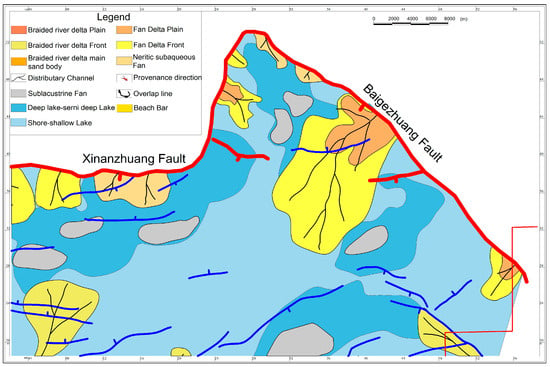
Figure 2.
Sedimentary facies plan of Es1 in Nanpu Sag.
2.3. Sequence Stratigraphy
After years of exploration and development, abundant data and materials have been accumulated in Nanpu Sag. A large number of studies have been carried out on the geological structure, sedimentation, reservoir and oil bearing in the study area, and certain understandings have been obtained [27,28]. The exploration has confirmed several sets of oil-bearing layers, revealing that the depression has great potential.
The Nanpu Sag is dominated by Cenozoic deposits, with the Paleogene Shahejie Formation (Es), Dongying Formation (Ed), Neogene Guantao Formation, Minghuazhen Formation and Quaternary Pingyuan Formation developing successively from bottom to top. The maximum sedimentary thickness is 8000 m [29]. The Es and Ed developed in the Nanpu Sag. The objective of this study is to focus on the sand body of Es1, with a formation thickness of about 500 m. It is currently the main target stratigraphy of the region, the main body of Palaeogene fault lake basin sedimentation in the Nanpu Sag [30], and also an important oil-bearing gas layer. The thickness of dark mudstone is 200–600 m (Figure 3). Based on the tectonic evolution characteristics, unconformity surfaces and sedimentary filling features of Nanpu Sag, combined with seismic reflection termination relationships, seismic facies patterns, well logging response characteristics and lithological variations, a sequence stratigraphic framework for the Shahejie Formation in Nanpu Sag has been established. From bottom to top, the Shahejie Formation is divided into four third-order sequences, namely SQ1, SQ2, SQ3 and SQ4.
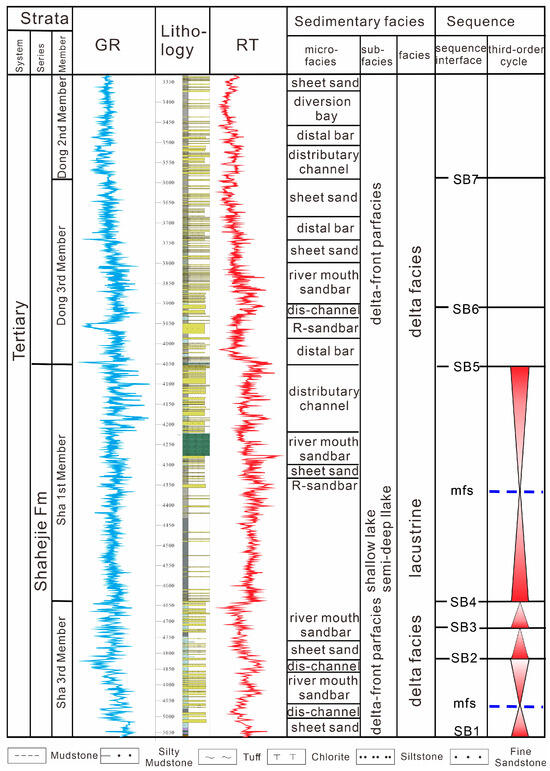
Figure 3.
Sequence stratigraphic analysis diagram of the study area.
The bottom interface of Es1 is in contact with the unconformity of Es3 of the interface, the formation of Es2 is missing, and the local salient position can be seen to cut the underlying layer. The logging is characterized by the sudden change of acoustic curve and resistivity, the lithology shows that the siltstone changes upward into mudstone or gray mudstone, and large sections of continuous mudstone can be seen above the lithology interface (Figure 3). The bottom of the Dongying Formation (Ed) is above the top interface (SB5) of Es1, which is in unconformity with the lower strata. The Es1L sequence exhibits high-amplitude, medium-to-high frequency reflection characteristics on seismic profiles, while the Es1U sequence shows moderate-to-high amplitude, medium-frequency reflection features. Localized erosional truncation of underlying strata can be observed in certain stratigraphic sections (Figure 1c). Core calibration data analysis reveals significant lithological variations at formation boundaries, characterized by transitions from siltstone to mudstone or calcareous mudstone and the presence of continuous thick mudstone intervals. These lithological changes correspond to abrupt shifts in acoustic transit time and resistivity anomalies on well logs, serving as key markers for sequence boundaries.
3. Sample and Method
All data utilized in this study were provided by the Exploration and Development Research Institute of PetroChina Jidong Oilfield Company. A systematic investigation was conducted on the distribution and characteristics of Es1 fan bodies in the northern Nanpu Sag through comprehensive analysis of drilling cores, full-coverage 3D seismic datasets (covering approximately 270 km2), lithological data, and well logging information. The methodology employed consisted of four main components: Firstly, detailed core examination and description were performed on 21.93 m of conventional coring samples (10 cm diameter) from three exploration wells within the study area. This included thin-section petrographic analysis to identify distinct lithofacies assemblages, sedimentary structures, and compositional characteristics. Secondly, high-precision synthetic seismograms (11.1 Hz dominant frequency) were used for seismic-well calibration, enabling accurate identification of stratigraphic interfaces through integration of 3D seismic data with log data. Thirdly, particular focus was placed on two key wells penetrating the target interval within the central depression zone NP4-68 and NP4-92, which served as primary evidence for fan body recognition. Additionally, structural elements of the fan systems were interpreted through horizontal distribution analysis of gamma ray (GR) and deep lateral resistivity (RLLD) logs from six strategically selected wells. The GR response with medium-low API values may indicate localized fluctuations caused by the incorporation of argillaceous debris. When the RLLD curve exhibits bell-shaped or funnel-shaped patterns, it reflects turbidite sand bodies characterized by poor vertical sorting. Finally, depositional facies types, including deltaic and gravity-flow fan systems, were identified through integrated analysis, supported by root-mean-square (RMS) attribute extraction to define their planar distribution limits. By synthesizing controlling factors, such as sediment supply dynamics, paleotopographic configuration, tectonic influences, and depositional processes, sublacustrine fan deposition models were established for the study area.
4. Results and Discussion
4.1. Core Characteristics
Identification of gravity flow deposits was based on lithologic characteristics and phase markers. The surrounding rock adjacent to the sandstone comprises dark mudstone of deep lacustrine facies, which represents one of the diagnostic features for identifying gravity flow deposits.
The Well NP4-68 core exhibits overall grayish-white massive sandbodies with locally observed thin-bedded lithological abrupt changes within certain sandstones (Figure 4c), irregular, differently sized sandstone vein injectites (Figure 4d), and rare occurrences of pulsating pebble-bearing intervals (Figure 4b). Thick-bedded massive sandstones without distinct bedding features are commonly observed in the core.
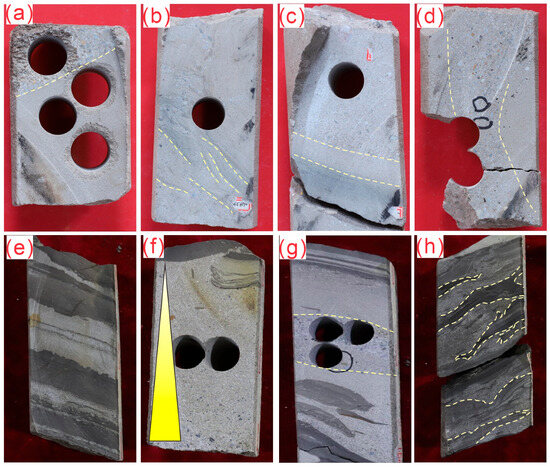
Figure 4.
Lithofacies classification and interpretation in the study area. (a) Well NP4-68, 4602.46 m, gravel-bearing coarse sandstone at the top, lumpy coarse sandstone at the bottom. (b) Well NP4-68, 4604.51 m, blocky coarse sandstone with floating gravel. (c) Well NP4-68, 4604.92 m, block gravel-bearing coarse sandstone at the top and block fine sandstone at the bottom. (d) Well NP4-68, 4607.26 m, blocky grits interspersed with blocky grits. (e) Well NP4-92, 4160.27 m, with fine sandstone sandwiched in flame-like structural mudstone and interbedded with sand and mud. (f) Well NP4-92, 4160.70 m, the top is blocky coarse sandstone with downward grain size gradually changing to blocky gravel-bearing coarse sandstone. (g) Well NP4-92, 4160.3 m, primarily consists of massive fine sandstone, with a small amount of sand-mud interbedding at the top. The middle section contains massive, gravelly, coarse sandstone, while the lower section is rich in muddy clastic fragments. (h) Well NP4-92, 4165.14 m, cross-bedded mudstone, interspersed with multiple thin sand layers.
In contrast, the Well NP4-92 core contains abundant irregular dark-gray mudstone rip-up clasts, with local development of cross-bedding (Figure 4g,h). Thin parallel laminations overlain by dark-gray mudstone layers occur at the top of certain massive sandbodies, accompanied by flame structures (Figure 4e). Vertical lithological transitions showing normal gradational sequences from coarse sandstone to pebbly coarse sandstone are observed in some intervals (Figure 4f).
4.2. Interpretation
The Well NP4-68 exhibits sediment deformation processes where semi-consolidated deposits underwent translational block movement along planar sliding surfaces under specific mechanical conditions (Figure 4a). Rapid shifts in hydrodynamic energy can generate “coarse–fine” rhythmic bedding through abrupt lithological changes in thin sandbodies. This phenomenon results from strong turbidity currents transporting coarse-grained sediments, followed by fine-grained muddy deposition during subsequent low-energy phases, creating sharp vertical lithological contacts. Under intense compressional stress, early-stage conglomerate layers may experience ductile shear deformation, forming lens-shaped clasts with preferred orientation.
In the NP4-92 core, sediment deformation influenced by dispersed pressure, matrix strength and buoyancy effects demonstrates chaotic suspension of quartz grains and mudstone rip-up clasts within deposits [21]. This reflects shear strength differences between sandstone and mudstone—competent sandstone resists deformation while weaker mudstone undergoes irregular tearing. During gravity flow termination, when underlying mudstones become plastic, overlying sandbodies may sink into the substratum, accompanied by upward mud intrusion, manifesting as flame structures. Normal gradational sequences in these deposits record a progressive decline in hydrodynamic energy.
The lithology of Es1 sand bodies in the study area is predominantly medium-fine sandstone, with sampled cores obtained from depths of 4000–4500 m. The principal rock types of Es1 consist of lithic arkose and feldspathic litharenite. Sandstone compositions in the study area contain 30–45% quartz, averaging 19–41% feldspar, and 19–31% lithic fragments, predominantly acidic and metamorphic clasts (Table 1). Microscopic observations reveal lithic components, mainly comprising intermediate-acidic volcanic rocks, granites, quartzites, with minor carbonate rocks, schists, and tuffs, occasionally containing mica and chlorite schist fragments. Petrographic features include sporadic quartz overgrowths, carbonate cements (ankerite, calcite, minor dolomite) filling pores and replacing grains, with occasional siderite and zircon heavy minerals observed in pore spaces. The rocks contain oily bitumen at medium-low concentrations (Figure 5).

Table 1.
Terrigenous clastic range and mean values table for Es1 in the study area.

Figure 5.
Microscopic characteristics of Es1 in the study area. (a) Well GS1, 4163.5 m, gray fine-grained sandstone (cross-polarized light). (b) Well GS1, 4518.35 m, gray medium-grained sandstone (cross-polarized light). (c) Well NP4-92, 4161.35 m, grayish-white medium-grained sandstone (cross-polarized light). (d) Well NP4-92, 4163.35 m, grayish-white medium-grained sandstone (cross-polarized light).
Feldspar components consist of both plagioclase and potassium feldspar. The sandstones exhibit moderate textural maturity with wide grain size distributions (0.10–0.28 mm average diameter, 0.18 mm mean), developing fine to medium-coarse sandstones. Sorting coefficients range 1.32–2.84 (average 1.97), indicating poor to moderate sorting (Table 2). Grain roundness displays sub-angular to sub-rounded characteristics with moderate sphericity, corresponding to medium structural maturity. The reservoir exhibits a grain-supported framework with pore-filling cementation patterns.

Table 2.
Clastic rock texture-cementation characteristics statistical table for Es1 in the study area.
4.3. Characteristics of Lithofacies Assemblages
The core shows that the sublacustrine fans deposited in the study area developed a slump structure, massive bedding, flame structure, mudstone tearing debris, and significant gravity flow characteristics. Well NP4-92 shows vertical superposition of tooth-box and bell-shaped characteristics, and Well NP4-68 shows giant micro-tooth-box characteristics (Figure 6 and Figure 7).
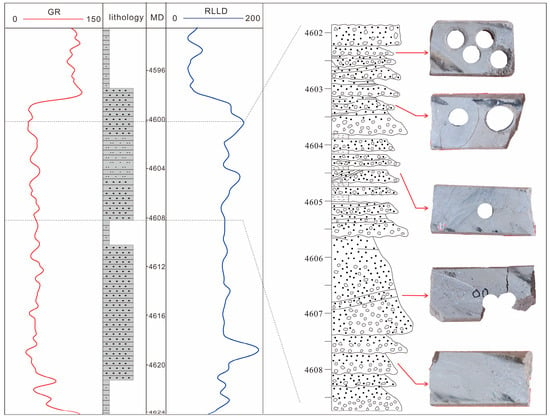
Figure 6.
Analysis of sublacustrine fan core facies of Well NP4-68 in the study area.
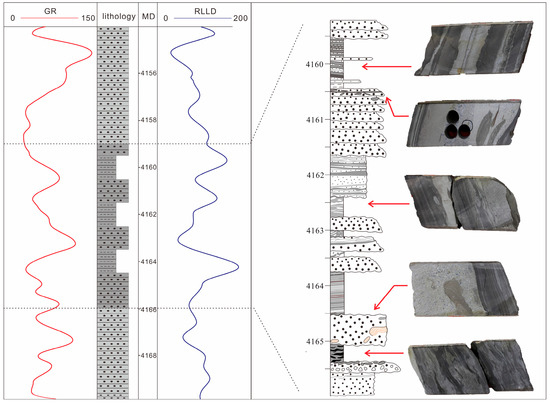
Figure 7.
Analysis of sublacustrine fan core facies of Well NP4-92 in the study area.
Through petrographic analysis of core wells in the study area, four petrographic combinations were identified, as shown in Figure 8.

Figure 8.
Typical core facies assemblage characteristics of gravity flow in Es1 in Nanpu Sag. (a) Sandstone and mudstone assemblage; (b) siltstone and mudstone assemblage; (c) combination of fine sandstone and medium sandstone; (d) the combination of pebbled sandstone and mudstone.
(a) Sandstone and mudstone assemblage. The lithology is mainly light gray sandstone and gray black mudstone, parallel bedding is developed, local sandstone bottom can develop scour surface, deformation bedding and cross-bedding can be seen. It can be seen that siltstone with different particle sizes and colors is produced along the bedding, and the lower part of the sandstone section develops argillaceous siltstone, and the black mudstone is in the interactive transition of tearing and gray siltstone. This lithologic assemblage is mainly developed in the upper part of Es1 of Well NP4-92.
(b) Siltstone and mudstone assemblage. The lithology is mainly siltstone and gray-black mudstone with a small amount of fine sandstone. The upper mudstone as a whole develops parallel bedding, while the lower mudstone develops flame-like syngenetic deformation structure. This is because the lower mudstone cannot evenly carry the overlying sand body, causing the sandstone to fall into the mudstone irregularly. At the same time, the lower mudstone will also deform and run upward into the sandstone, forming a flame-like structure, which proves that the deformation occurred due to gravity, sliding and slump tearing before the sediment consolidation.
(c) Bedded fine-grained sandstone transitions into a medium-grained sandstone assemblage. The lithology is mainly light gray block fine sandstone and medium sandstone. The sandstone segment develops complex positive grain sequence bedding, showing the fluid energy changes from strong to weak and repeated turbulence, and no other bedding develops inside except the grain size gradient. Some of the sandstone developed slump deformation structure, and the sandstone was occasionally intermixed with gray black mud, gravel and mud strip, which is the displacement of mudstone under the action of gravity during the deposition process, resulting in deformation and tearing of the sand body.
(d) Bedded conglomeratic sandstone and mudstone assemblage. The lithology is a combination of blocky multiple sets of sandstone with thin layers of mudstone and rhythmic bedding. The combination of sandstone and thin layers of mudstone repeats regularly in the vertical direction. Each set of sandstone combinations is a gravel-bearing coarse sandstone with upward granularity thinning, which also shows the repeated changes of water energy.
4.4. Grain Size Characteristics
The grain size probability cumulative curves of the Well NP4-68 sandbody in Es1 predominantly exhibit a traction–suspension type pattern, lacking rolling components and dominated by traction and suspension populations (Figure 9). The traction–suspension transport mechanism refers to sedimentary particles being classified into two kinematic types based on their movement modes: traction components (larger, denser grains) and suspension components (smaller, lighter grains), reflecting distinct transport mechanisms. Gravity flow deposits differ from normal hydraulic processes through combined particle motion patterns involving both traction and suspension within fluid media. The probability curves of Well NP4-68 display an arcuate upward-convex morphology with intersection values between traction and suspension components at approximately Φ = 3, where slope variations indicate transitional hydrodynamic regimes from traction-dominated to suspension-dominated transport. The suspended fraction dominates with a mass proportion of approximately 60%. The grain-size distribution curve exhibits an initial steep slope that subsequently flattens (Figure 8), indicative of turbulent-supported suspension transport mechanisms. The broad φ-value range, combined with calculated sorting coefficients (S0) of approximately 2.5 and 3.3, demonstrates poor sorting characteristics consistent with rapid deposition from gravity flows [31]. These grain size distribution characteristics suggest deposition in environments with steep paleo-gradients and high sedimentation rates. Consistency across all 64 analyzed samples from Well NP4-68 confirms systematic genetic origins, supporting the interpretation that they are sublacustrine fan deposits formed through hyperpycnal gravity flows.
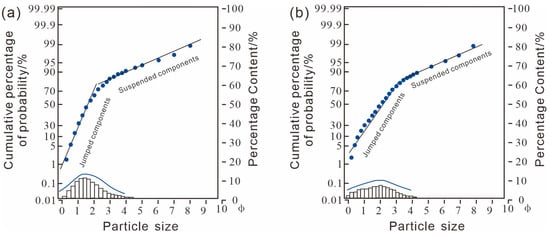
Figure 9.
Grain size probability curve of sand body in Es1 of Well NP4-68. (a) NP4-68, 4606.93 m; (b) NP4-68, 4607.22 m.
4.5. Characteristics of Sand Body Profile
The identification of sublacustrine fan distributions through seismic sedimentology holds significant implications for establishing depositional models. Based on seismic profiles (Figure 10), distinct seismic reflections and sedimentary characteristics can be identified. Fan deltas exhibit medium-amplitude reflective seismic facies, characterized by stable sedimentary patterns in cross-sections [32]. These are manifested as subparallel seismic reflections with moderate continuity, where reflection events often downlap onto the basal surface, indicating progradation of sediments into the lake basin influenced by sediment supply or tectonic activity. The underlying surfaces of clinoforms show a slight inclination, with proximal onlap and distal downlap observed. Sublacustrine fans predominantly develop in Es1, displaying wedge-shaped or base-flat-top-convex seismic geometries that thin bilaterally and pinch out laterally. Lenticular reflection structures are observed in sublacustrine low-relief highs and slope zones.
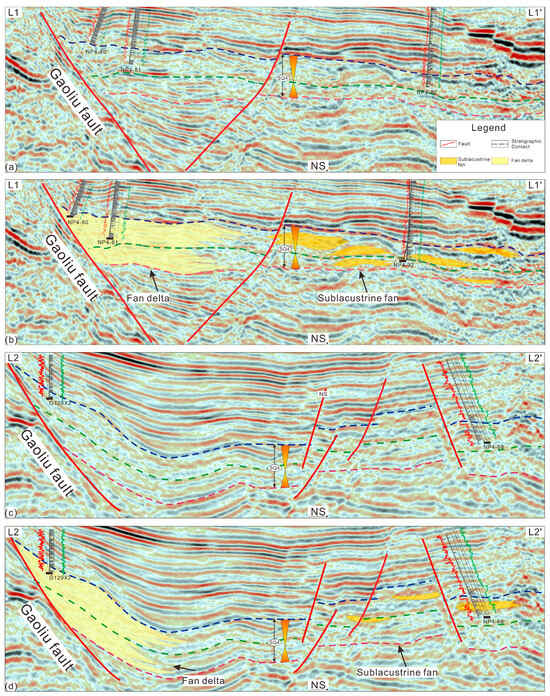
Figure 10.
Seismic profile distribution map of sand bodies in Es1, study area. (a) seismic profile at location L1; (b) fan depositional profile at location L1; (c) seismic profile at location L2; (d) fan depositional profile at location L2.
Wells NP4-80, NP4-81, and G129X2 primarily consist of light gray siltstone interbedded with multiple thin mudstone layers. Well NP4-80 exhibits serrated-box and funnel-shaped well-logging curves, while NP4-81 shows predominantly serrated-box patterns. In contrast, Well G129X2 displays box-shaped and serrated curves. Well NP4-92 contains thick mudstone sequences intercalated with minor siltstone, with logging curves characterized by serrated and serrated-box morphologies (Figure 10). Integrated seismic and well-log analysis reveals that Es1 in the study area features both sublacustrine fans and fan delta deposits. Fan delta systems exhibit early progradational and late retrogradational stacking patterns. Vertically, multiple phases of sublacustrine fan sand bodies are developed, each separated by thick mudstone layers [33].
4.6. Characteristics of Sand Body Plane
Identifying the plane distribution of sublacustrine fans by seismic sedimentology is of great significance for establishing a sedimentary genetic model. In order to clarify the vertical evolution law and plane distribution characteristics of sublacustrine fans, the seismic attribute study (Figure 11) is used to further understand the plane distribution and evolution law of sublacustrine fans in the sequence framework.
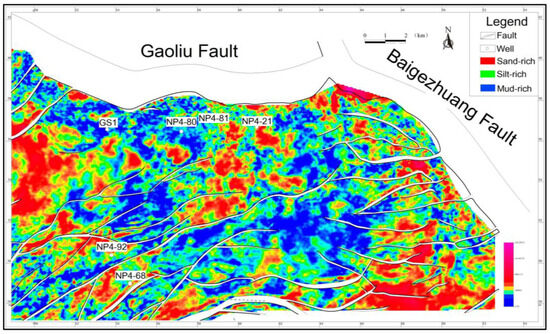
Figure 11.
RMS attribute feature diagram of Es1 in the study area.
The provenance of the sublacustrine fans in Es1 mainly comes from the northern Gaoliu Area. In the deposition period of Es1, the fault depression period gradually changed to the fault depression period, and it was easy to deposit the sublacustrine fans in the steep slope zone and depression area [34]. The fan delta developed in the sedimentary area after the long-distance transport of the provenance in Es1. The fan delta in the source area provided a large amount of detrital material for the sublacustrine fans and formed the sublacustrine fan deposits in the central depression area. In terms of RMS seismic properties, the sand body of Es1 in the study area is shown as an orange-red area with a clear distribution range, which is obviously different from the green and blue areas rich in mud (Figure 11) [35]. The sublacustrine fans in the study area showed an inverse gradient of upward coarsening of particle size and an upward increase of sediment thickness (Figure 12).
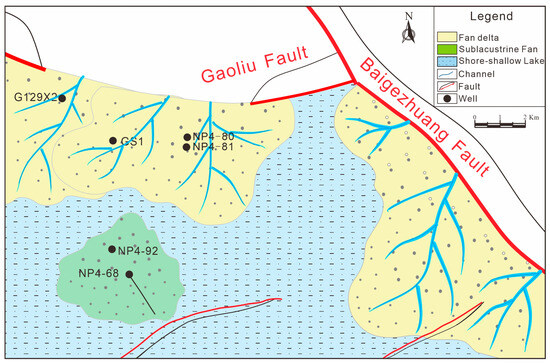
Figure 12.
Planar facies feature diagram of the sedimentary facies of Es1 in the study area.
4.7. Tectonic Settings and Provenance
The formation of gravity flow deposits in lacustrine basins is primarily controlled by sediment supply, paleogeomorphology, and faulting activities [36,37]. The petrographic study of the detrital sandstone composition is an excellent approach to determining its tectonic settings and source type [38]. The Nanpu Sag in the Es1 sublacustrine fan core exhibits characteristic sedimentary features, including lenticular gravel clasts, rhythmic bedding, mudstone rip-up clasts, and flame structures. These depositional phenomena result from syn-sedimentary tectonic activity of the Gaoliu Fault, which generated intense compressional stresses and fluctuating hydrodynamic energy during sedimentation. The observed deformation textures arise from differential mechanical responses between sandstone and mudstone layers; under tectonic compression, the less competent mudstone units undergo brittle fracturing and plastic flow deformation, producing both torn fragments (rip-up clasts) and flame structures through fluid escape mechanisms within water-saturated sediments [39].
According to previous studies on the regional tectonic units of Nanpu Sag and its adjacent areas, Es1 in Nanpu Sag extends to the Yanshan Fold Belt, indicating sustained sediment availability with a long-term provenance background. Gaoliu Fault, functioning as a major syn-depositional growth normal fault, dominantly controls the depositional patterns and distribution of Es1 and Dongying Formation strata in the study area. During the Es1 deposition period, the eastern segment of the Gaoliu Fault was laterally juxtaposed against the Baigezhuang Fault, while its western segment connected with the Xinanzhuang Fault in an isolated configuration. Both flanks of the Gaoliu Fault maintained continuous activity during this interval, entering the initial activation phase with slip rates peaking at 174.7 m/Ma [40]. A transtensional transition zone developed along the Gaoliu Fault during the Es1 deposition period [41]. While northern-derived sediments entered the system, fault-induced subsidence created accommodation space, enabling fan delta progradation. Subsequent gravitational collapse of fan delta fronts under combined influences of steepened topography and fault-controlled subsidence led to the accumulation of mass transport deposits within the central depression zone, forming characteristic sublacustrine fans through repeated sediment remobilization processes [13].
4.8. Depositional Model and Sedimentary Environment
Stratal disturbances induced by fault movements modified terrain gradients and disrupted stratigraphic continuity, creating favorable conditions for sediment sliding and slumping [42]. The differential uplift between hanging wall and footwall of the Gaoliu Fault generated significant vertical displacement (up to 350 m paleo-relief) and slope gradients, establishing north-high and south-low topographic framework that served as preferential conduits for sediment transport, ultimately facilitating sublacustrine fan development.
Based on the aforementioned analysis, during the early stage of Gaoliu Fault activity, characterized by intense fault movement and abundant sediment supply from the northern Baigezhuang provenance, substantial clastic materials were transported into the hanging wall block of the Gaoliu Fault. The tectonic stresses generated by fault displacement compromised slope stability along steep gradients, leading to recurrent slope failure and gravitational collapse processes that remobilized fan delta deposits into lacustrine environments. These mass transport mechanisms facilitated sublacustrine fan development within the central depression zone through continuous debris influx from fan delta systems, which served as primary sediment sources. The syndepositional faulting process concurrently induced subtle paleogeomorphic adjustments that systematically directed sediment dispersal pathways while establishing critical depositional conditions for fan formation. Specifically, the underlying fault architecture exhibiting inverse step-fault configurations effectively constrained sandbody distribution patterns and spatially restricted the developmental location of sublacustrine fan deposition through structural compartmentalization effects (Figure 13).
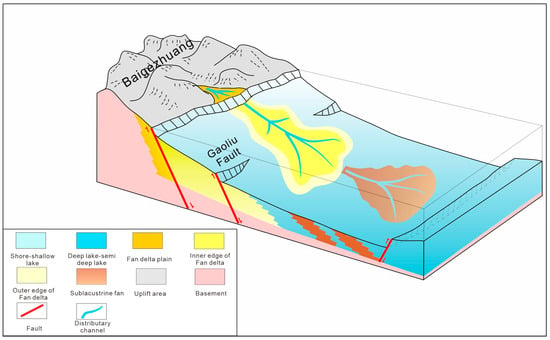
Figure 13.
Sedimentary model of sublacustrine fans in Es1, Nanpu Sag.
5. Conclusions
The integrated analysis of drilling/logging, analytical laboratory data, and 3D seismic datasets has been conducted to investigate the Es1 sandbody characteristics within the northern central depression zone of Nanpu Sag. Multiple gravity flow sedimentary structures with distinct diagnostic features have been identified through core examination, leading to the establishment of four characteristic lithofacies associations. The tectonic activity of the Gaoliu Fault during the Es1 deposition plays a critical role in controlling sublacustrine fan development. Fault-induced differential uplift between hanging wall and footwall created significant paleotopographic relief (>height difference increase), while fault-associated structural stresses destabilized slope systems, triggering gravitational remobilization processes that transported fan delta deposits downslope as slump masses into the central depression area to form sublacustrine fans. Furthermore, underlying fault systems exhibiting inverse step-fault configurations effectively constrain the spatial distribution of sandbodies and restrict the primary developmental location for fan unloading through structural compartmentalization mechanisms. Combining the macroscopic identification of sedimentary characteristics and the establishment of depositional models with micro-scale analysis of hydrocarbon potential features can significantly enhance the accuracy of petroleum exploration and development efforts.
Author Contributions
Conceptualization, H.W.; Methodology, H.W.; Software, C.H. and X.Y.; Validation, Z.W.; Formal analysis, C.H. and X.Y.; Investigation, Z.M.; Resources, Z.W. and L.M.; Data curation, Z.W. and Z.M.; Writing—original draft, Z.W. and Z.M.; Writing—review and editing, Z.W. and Z.M.; Visualization, Z.W. and Z.M.; Supervision, H.W.; Project administration, Z.W., L.M., and R.Y.; Funding acquisition, Z.W., L.M., R.Y. and H.Y. All authors have read and agreed to the published version of the manuscript.
Funding
This work was financially supported by the National Natural Science Foundation of China (Grant No. 42372150) and China Postdoctoral Science Foundation (Grant No. 2023M733883).
Institutional Review Board Statement
Not applicable.
Informed Consent Statement
Not applicable.
Data Availability Statement
The original contributions presented in the study are included in the article, further inquiries can be directed to the corresponding author.
Conflicts of Interest
The authors declare no conflicts of interest.
References
- Lv, J.; Guo, X.; Yang, J. Development status and trend of deepwater oil-gas exploration and development technology. Oil Drill. Prod. Technol. 2015, 37, 13–18. [Google Scholar]
- Chen, D.; Pang, X.; Jiang, Z.; Zeng, J.; Qiu, N.; Li, M. Reservoir characteristics and their effects on hydrocarbon accumulation in lacustrine turbidites in the Jiyang Super-depression, Bohai Bay Basin, China. Mar. Pet. Geol. 2009, 26, 149–162. [Google Scholar] [CrossRef]
- Mansurbeg, H.; Morad, S.; Salem, A.; Marfil, R.; El-Ghali, M.A.K.; Nystuen, J.P.; Caja, M.A.; Amorosi g, A.; GarciaLa, D.; Iglesia, A. Diagenesis and reservoir quality evolution of palaeocene deep-water, marine sandstones, the Shetland-Faroes Basin, British continental shelf. Mar. Pet. Geol. 2008, 25, 514–543. [Google Scholar] [CrossRef]
- Tomassi, A.; de Franco, R.; Trippetta, F. High-resolution synthetic seismic modelling: Elucidating facies heterogeneity in carbonate ramp systems. Pet. Geosci. 2025, 31, 2024–2047. [Google Scholar] [CrossRef]
- Li, P.; Wang, Y.; Liu, J.; Liang, M. Evaluation of carbon emission efficiency and analysis of influencing factors of Chinese oil and gas enterprises. Energy Sci. Eng. 2025, 13, 1156–1170. [Google Scholar] [CrossRef]
- Johnson, D. Origin of submarine canyons. J. Geomorph. 1938, 1, 324–340. [Google Scholar]
- Ma, Z.W.; Guan, D.Y.; Wang, Q.M.; Liu, Y.J.; Li, X.H. Sedimentary characteristics and controlling factors of sublacustrine fans of the Third member of Paleogene Dongying Formation in Liaozhong Sag. Lithol. Reserv. 2022, 34, 131–140. [Google Scholar]
- Cui, J.W.; Zhu, R.K.; Xu, W.L. New cognition and isochronous stratigraphic division scheme of the Yanchang Formation sedimentation in Ordos Basin. J. Palaeogeogr. 2023, 25, 93–104. [Google Scholar]
- Guan, D.; Du, X.; Wang, Q.; Wang, Z. Development Characteristics and Sedimentary Model of Sublacustrine Fan of Channel Type in the Third Member of Shahejie Formation in the Northern Laizhou Bay Depression, Bohai Sea Area. Earth Sci. 2023, 48, 503–516. [Google Scholar]
- Bai, X.; Li, J.; Chen, F.; Li, Y.; Lu, S.; Hou, S.; Zheng, Q.; Zou, Y.; Tian, Y.; Li, M.; et al. Breakthrough and significance of tight oil exploration in Cretaceous Nantun Formation of Hailaer Basin. Acta Pet. Sin. 2024, 45, 1579. [Google Scholar]
- Deng, Y.; Hu, D.; Zhu, J.; Liu, G.; Chen, K.; Tong, C.; Zhang, D.; Xu, X.; Man, Y.; You, J.; et al. Hydrocarbon accumulation regularities, new fields and new types of exploration, and resource potentials in Beibuwan Basin. Acta Pet. Sin. 2024, 45, 202. [Google Scholar]
- Stow, D.A.V.; Mayall, M. Deep-water sedimentary systems: New models for the 21st century. Mar. Pet. Geol. 2000, 17, 125–135. [Google Scholar] [CrossRef]
- Yang, T.; Cao, Y.C.; Tian, J.C. Discussion on Research of Deep-water Gravity Flow Deposition in Lacustrine Basin. Acta Sedimentol. Sin. 2021, 39, 88–111. [Google Scholar]
- Yang, X.; Chang, L.; Xu, R.; Cheng, D.; Yin, Z.; You, J.; Liu, K.; Hu, G. Types and Sand Control Effect of Terrestrial Slope Breaks of Wenchang Sag inside the Pearl River Mouth Basin. Earth Sci. 2020, 45, 989–997. [Google Scholar]
- Pang, X. Key challenges and research methods of petroleum exploration in the deep of superimposed basins in western China. Oil Gas Geol. 2010, 31, 517–534+541. [Google Scholar]
- Mu, X.L.; Chang, S.Y.; Niu, L.L. Study on seismic sedimentology of middle-deep sand bodies in faulted lacustrine basin: Taking the upper third member of Dongying Formation in Laoyemiao area of Nanpu Sag as an example. Mar. Orig. Pet. Geol. 2024, 29, 327–336. [Google Scholar]
- Li, M. Study on Provenance and Sedimentary System of Paleogene in Nanpu Sag; China University of Petroleum East China: Qingdao, China, 2014. [Google Scholar]
- Sun, D. Study on the Acidizing Technology of Carbonate Reservoir in the Ordovician of Nanpu; SouthWest Petroleum University: Chengdu, China, 2017. [Google Scholar]
- Gong, L.; Qin, X.; Lu, J.; Gao, Y.; Meng, L.; Yuan, H.; Lu, Q.; Yin, X. Fractures development characteristics and distribution prediction of carbonate buried hills in Nanpu Sag, Bohai Bay Basin, China. Nat. Gas Geosci. 2024, 9, 417–430. [Google Scholar] [CrossRef]
- Zhang, J.; Li, K.; Wang, Q.; Wang, Z.; Han, J. Sedimentary characteristics and model of Paleogene gravity flow in Nanpu Sag, Bohai Bay Basin. Acta Sedimentol. Sin. 2017, 35, 1241–1253. [Google Scholar]
- Wang, Q.M.; Du, X.F.; Guan, D.Y.; Zhang, H.G.; Fu, X. Sedimentary Characteristics and Development Pattern of Sublacustrine Fan in the Third Member of Dongying Formation in the South-Central Western Slope of Liaozhong Sag. Earth Sci. 2023, 48, 2979–2992. [Google Scholar]
- Sun, Z.; Lin, S.; Wang, G.; Liu, L.; Wang, M. Sedimentary evolution pattern influenced by sequence stratigraphy: A case study of the Nanpu Sag, Bohai Bay Basin, China. Geosci. Lett. 2024, 11, 30. [Google Scholar] [CrossRef]
- Xia, J.S.; Liu, X.; Li, W.H.; Zhang, B.M.; Wen, W.; Li, H.; Fan, R.; Xue, L. Study on high-resolution sequence stratigraphy and sedimentary system of middle-deepbeds on western slope, Nanpu sag. China Pet. Explor. 2017, 22, 72. [Google Scholar]
- Yu, Z.; Chen, S.; Xie, W.; Zhao, S.E.; Ma, J.; Gong, T. Implication linkage among Microfacies, Diagenesis, and Reservoir properties of sandstones: A case study of dongying formation, Nanpu Sag, Bohai Bay Basin. Energies 2022, 15, 7751. [Google Scholar] [CrossRef]
- Fang, X.X.; Wang, H.; Jiang, H. Sedimentary System Analysis of Dongying Formation in Liu Nan Area, Nanpu Sag. Geol. Sci. Technol. Inf. 2010, 29, 38–43. [Google Scholar]
- Xian, B.Z.; Wan, J.F.; Jiang, Z.X. Gravity flow sedimentary characteristics and pattern in sag basin depression belt: Taking the eastern section of Nanshuo depression in the Dongying Formation as an example+. Front. Geosci. 2012, 19, 121–135. [Google Scholar]
- Cuimei, Z.; Xiaofeng, L.; Ming, S. Structural-Sedimentary Analysis of the Laoyemiao Area in the Nanpu Sag. Earth Sci. (J. China Univ. Geosci.) 2009, 34, 829–834. [Google Scholar]
- Wang, E.Z.; Liu, G.Y.; Pang, X.Q.; Li, C.R.; Wu, Z.Y. Diagenetic Evolution Characteristics and Genetic Mechanism of the Middle-Deep Clastic Reservoirs in the Nanpu Sag. Pet. Explor. Dev. 2020, 47, 321–333. [Google Scholar] [CrossRef]
- Jing, Y.; Lei, C.; Liu, K.; Li, Z. Deposition environment and provenance of the Palaeogene Shahejie Formation in Nanpu Sag: Evidences from trace and rare earth element geochemistry. Bull. Geol. Sci. Technol. 2023, 42, 350–359. [Google Scholar]
- Li, S.M.; Pang, X.Q.; Wan, Z.H. Mixed oil distribution and source rock discrimination of the Nanpu depression, Bohaibay basin. Earth Sci. (J. China Univ. Geosci.) 2011, 36, 1064–1072. [Google Scholar]
- Nan, J.H.; Sha, Z.L.; Li, Y.; Kong, F.S.; Liu, S.R.; Hou, S.Y.; Yu, X.D. Sedimentary characteristics of gravity flow deposits during the fault depression period in small faulted basins of Wubei sub-sag in Hailar Basin. J. China Univ. Pet. 2025, 49, 56–67. [Google Scholar]
- Wu, K.; Wu, J.G.; Zhang, Z.Q.; Jin, X.Y.; Liu, Y.J.; Yu, Q. Sedimentary model and seismic response characteristics of the sublacustrine fan in northern Liaozhong Depression. J. Northeast Pet. Univ. 2012, 36, 33–37. [Google Scholar]
- Wang, H.; Jiang, S.; Zhang, Y.; Wang, X.; Liu, E.; Dong, X. Influence of Sublacustrine Fan Depositional Model on Distribution and Morphology of Reservoirs: A Case Study in Eastern Slope of Liaoxi Uplift, Bohai Bay Basin, East China. Energies 2023, 16, 851. [Google Scholar] [CrossRef]
- Huang, L.; Zhou, X.H.; Wang, Y.B.; Wei, A.J.; Liu, T.H.; Wang, Q. Cenozoic tectonic evolution and its control on the hydrocarbon accumulation of the western Bohai Sea. Chin. J. Geol. 2013, 48, 275–290. [Google Scholar]
- Zhang, X.; Zhu, X.; Lu, Z.; Lin, C.; Wang, X.; Pan, R.; Geng, M.; Xue, Y. An early Eocene subaqueous fan system in the steep slope of lacustrine rift basins, Dongying Depression, Bohai Bay Basin, China: Depositional character, evolution and geomorphology. J. Asian Earth Sci. 2019, 171, 28–45. [Google Scholar] [CrossRef]
- Liu, F.; Zhu, X.; Li, Y.; Xu, L.; Niu, X.; Zhu, S.; Liang, X.; Xue, M.; He, J. Sedimentary characteristics and facies model of gravity flow deposits of Late Triassic Yanchang Formation in southwestern Ordos Basin, NW China. Pet. Explor. Dev. 2015, 42, 633–645. [Google Scholar] [CrossRef]
- Xu, C.; Huan, L.; Song, Z.; Jia, D. Sequence stratigraphy of the lacustrine rift basin in the Paleogene system of the Bohai Sea area: Architecture mode, deposition filling pattern, and response to tectonic rifting processes. Interpretation 2020, 8, SF57–SF79. [Google Scholar] [CrossRef]
- Bilal, A.; Mughal, M.S.; Janjuhah, H.T.; Ali, J.; Niaz, A.; Kontakiotis, G.; Antonarakou, A.; Usman, M.; Hussain, S.A.; Yang, R. Petrography and provenance of the Sub-Himalayan Kuldana Formation: Implications for tectonic setting and Palaeoclimatic conditions. Minerals 2022, 12, 794. [Google Scholar] [CrossRef]
- Chen, J. Surface and subsurface reworking by storms on a Cambrian carbonate platform: Evidence from limestone breccias and conglomerates. Geologos 2014, 20, 13–23. [Google Scholar] [CrossRef]
- Wang, G.H.; Gan, H.J.; Zhao, Z.X.; Chen, S.B.; Zhao, Y.D.; Liao, J.N.; Li, X.N.; Wu, L.N. Tectonic Activity Characteristics of the Gaoliu Fault in the Nanpu Sag and Its Control over Sedimentation. J. Northeast Pet. Univ. 2018, 42, 51–61. [Google Scholar]
- Wan, J.F.; Xian, B.Z.; Li, Z.P.; Zhang, J.G.; Jiang, Z.X.; Wang, J.W. Different levels of rift activity and its impact on deposition in offshore area, Nanpu Sag. Acta Sedimentol. Sin. 2013, 31, 1059–1069. [Google Scholar]
- Ward, D.J. Dip, layer spacing, and incision rate controls on the formation of strike valleys, cuestas, and cliffbands in heterogeneous stratigraphy. Lithosphere 2019, 11, 697–707. [Google Scholar] [CrossRef]
Disclaimer/Publisher’s Note: The statements, opinions and data contained in all publications are solely those of the individual author(s) and contributor(s) and not of MDPI and/or the editor(s). MDPI and/or the editor(s) disclaim responsibility for any injury to people or property resulting from any ideas, methods, instructions or products referred to in the content. |
© 2025 by the authors. Licensee MDPI, Basel, Switzerland. This article is an open access article distributed under the terms and conditions of the Creative Commons Attribution (CC BY) license (https://creativecommons.org/licenses/by/4.0/).